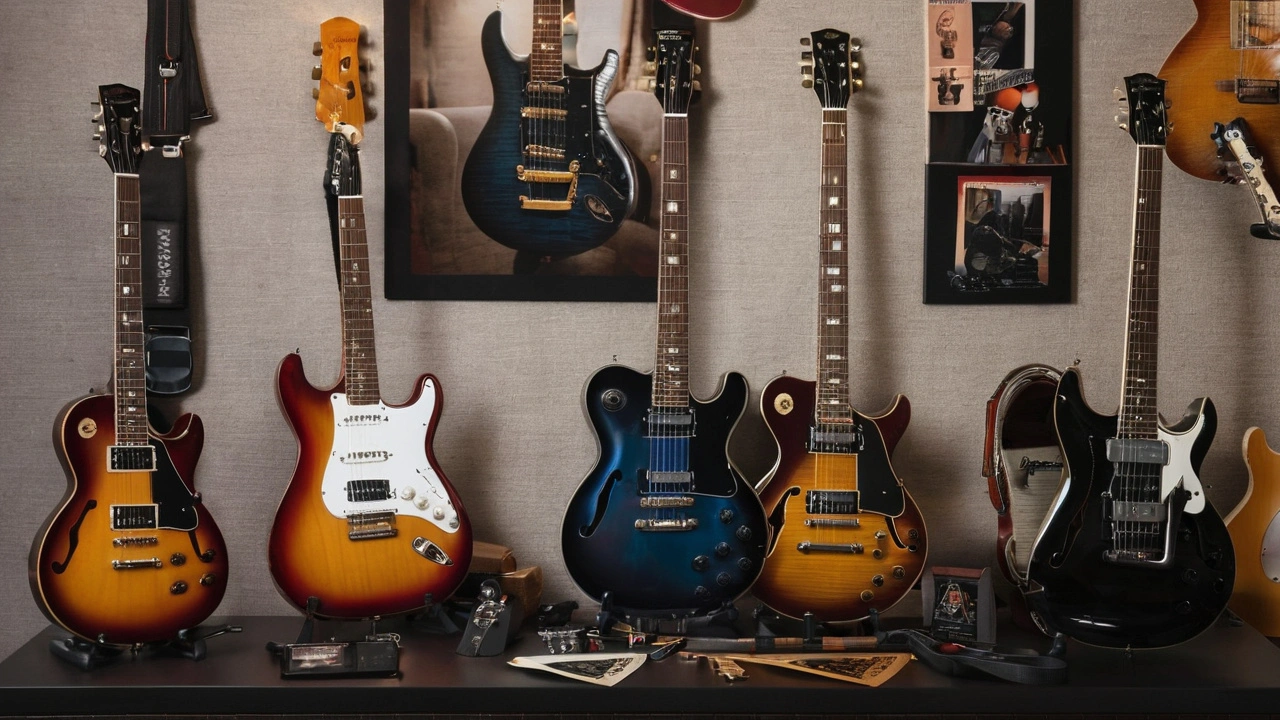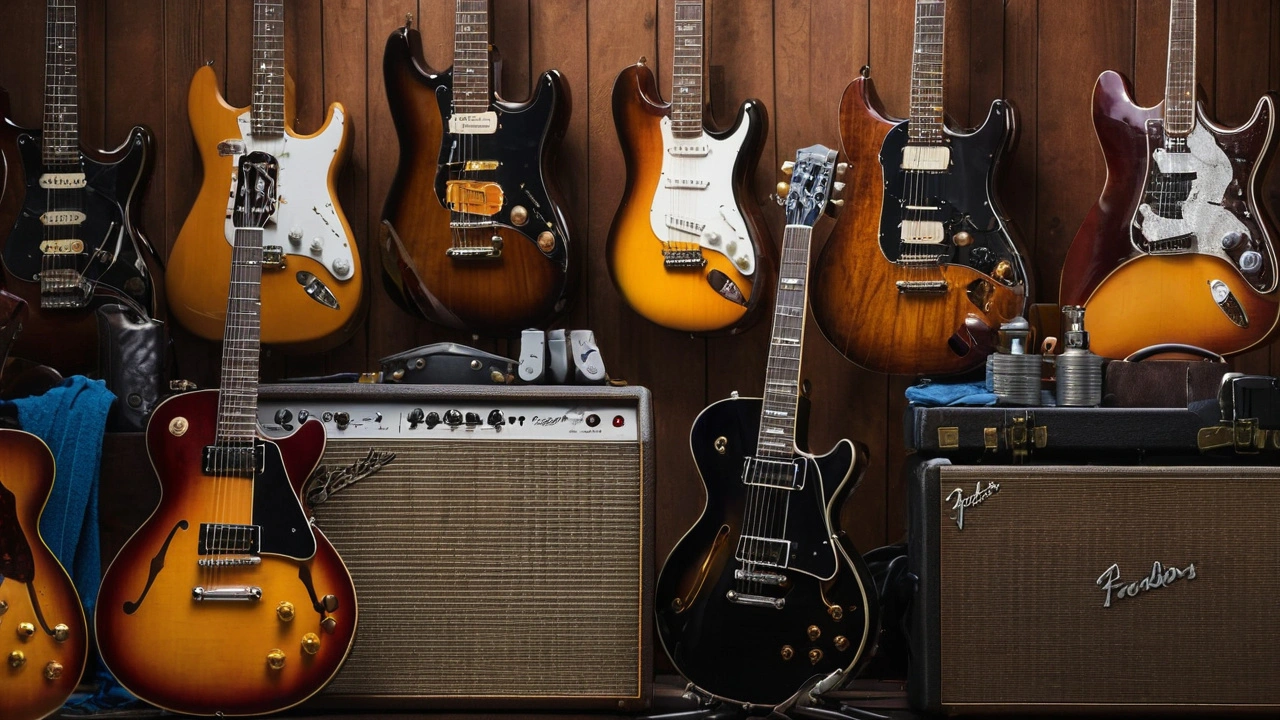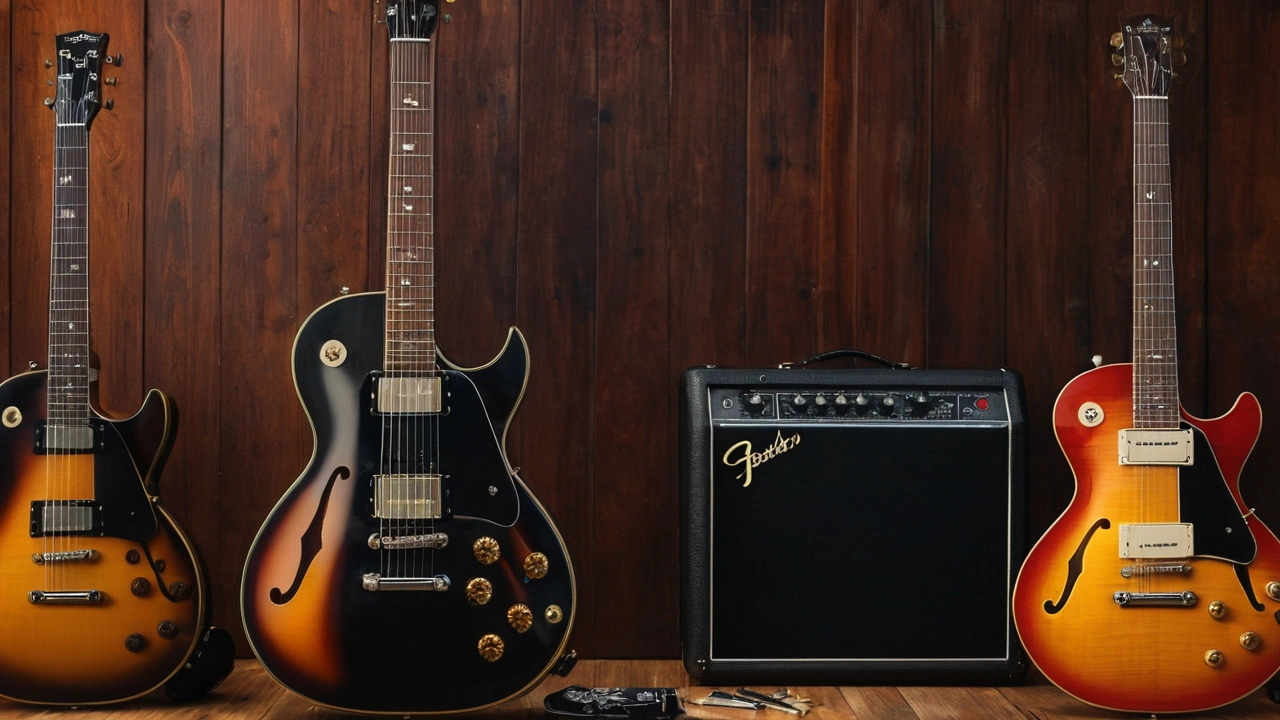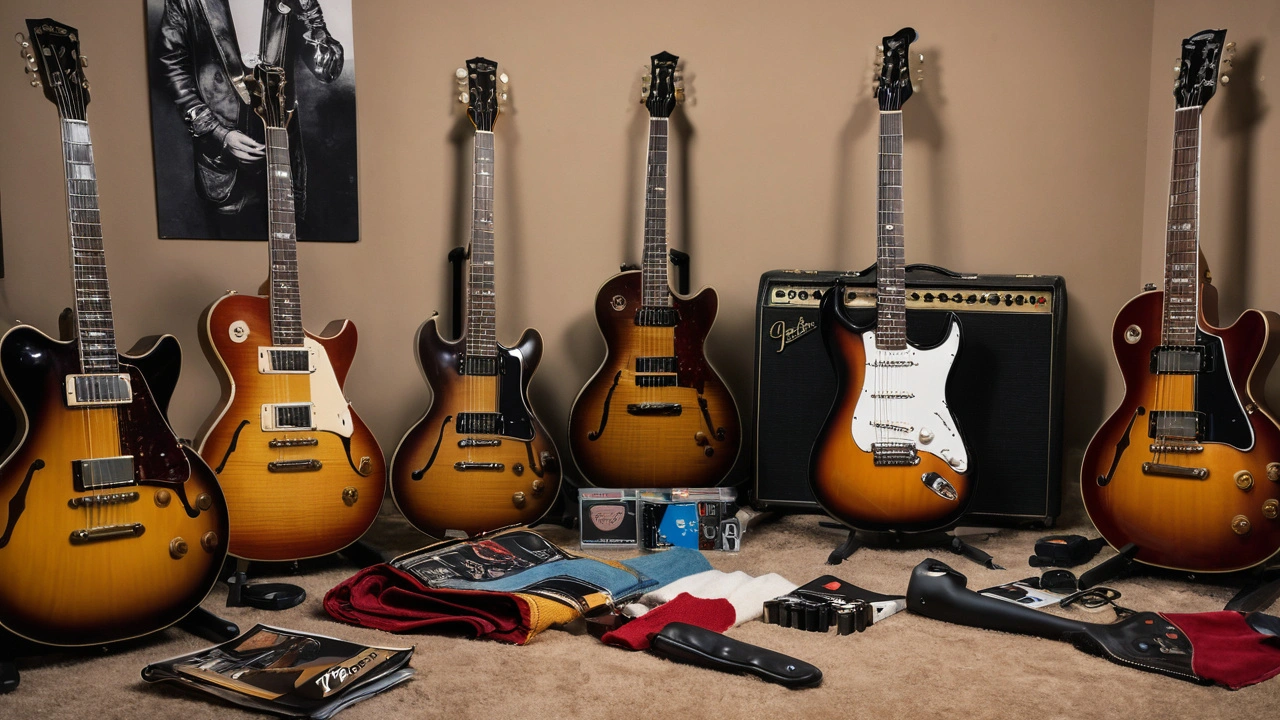The magic of electric guitars has enchanted musicians and music lovers alike for decades. With their versatility and unique sound, these instruments have a special place in the world of music.
This article aims to take you on a journey through the enchanting history and evolution of electric guitars, explain the different types available, delve into their key components and features, and provide useful maintenance tips.
Whether you're an aspiring guitarist or a seasoned player, this guide will offer valuable insights to deepen your connection with this amazing instrument.
History and Evolution
The journey of the electric guitar began in the early 20th century, a period that witnessed unprecedented innovations in music technology. The need for an amplified sound arose primarily due to the limitations of acoustic guitars which couldn't compete with the volume of brass instruments in big bands. This necessity spurred creative minds to experiment with electronically amplifying the sound of stringed instruments.
In the 1930s, Adolph Rickenbacker and George Beauchamp co-founded the Electro String Instrument Corporation and introduced the “Frying Pan” guitar, which was the first commercially sold electric guitar. This innovation featured a solid body and a single electric pickup, creating a new path for aspiring musicians. The sound produced by this guitar was rich and resonant, giving birth to a new era in music.
The 1950s marked a revolutionary period in the history of electric guitars with the introduction of iconic models like the Fender Telecaster and the Gibson Les Paul. Leo Fender, the brain behind Fender Musical Instruments Corporation, launched the Telecaster in 1950. It was the first mass-produced solid-body electric guitar, known for its bright tone and sustain. Similarly, in 1952, Gibson, under the guidance of Les Paul, a renowned guitarist and inventor, unveiled the Gibson Les Paul, which became a benchmark for quality in the music world. These guitars, with their distinctive shapes and sounds, captivated the imagination of countless artists.
The 1960s and 1970s saw electric guitars becoming an essential part of cultural movements. Rock and roll, blues, and later heavy metal genres were fundamentally shaped by the electric guitar's presence. Guitarists like Jimi Hendrix, who famously set his guitar on fire on stage, exemplified the electric guitar's wild and revolutionary spirit. Hendrix’s use of distortion, feedback, and his unique playing style demonstrated the unrivaled expressiveness and power of the electric guitar. David Byrne once said,
"Jimi Hendrix played loud and very advanced, but his parts were as soulful as anything you’d hear on a Stax record."
In the 1980s, the electric guitar underwent another transformation as new genres like glam metal and punk rock emerged. These genres demanded different tonal qualities, leading to the development of guitars with humbucking pickups, which reduced the noise and hum often associated with single-coil pickups. As a result, brands like Ibanez and Jackson became household names within the rock and metal communities, creating instruments specifically designed for fast, aggressive playing styles.
Today, the electric guitar continues to evolve, integrating modern technology to meet the diverse needs of contemporary musicians. Digital modelling, MIDI compatibility, and advanced pickup technologies have expanded the way musicians can manipulate sound. The electric guitar has come a long way from its humble beginnings, embodying a rich history of innovation and creativity that continues to shape modern music. If you're considering getting an electric guitar or just want to appreciate its legacy, knowing its history can certainly deepen your understanding and enhance your playing experience.

Types of Electric Guitars
When diving into the vast world of electric guitars, one quickly realizes the diversity these instruments offer. Each type brings its own unique characteristics and sound, making it essential to understand what sets them apart. The most common types include solid-body, hollow-body, and semi-hollow body guitars. Let's look at each in detail.
Solid-Body Electric Guitars
Perhaps the most popular and widely recognized, solid-body electric guitars have a solid wooden body with no hollow spaces. This design minimizes feedback and produces a more sustained sound. Icons like the Fender Stratocaster and Gibson Les Paul fall under this category. These guitars are versatile, suitable for various genres ranging from rock to jazz. The invention of the solid-body guitar is often attributed to Les Paul himself, who wanted to reduce feedback in performances.
"Solid-body guitars revolutionized the music industry and paved the way for modern rock and roll," said renowned guitarist and historian Andy Summers.
The absence of a resonating cavity means the sound is less influenced by the body material, making pickups and electronics more critical in defining the tone. Solid-body guitars are also typically lighter and more durable, perfect for musicians on the go.
Hollow-Body Electric Guitars
Hollow-body guitars, as the name suggests, have a completely hollow body that resembles that of an acoustic guitar. This design gives them a warm, resonant sound that is distinctly different from their solid-body counterparts. They are often found in jazz, blues, and rockabilly genres. However, due to their hollow construction, they are more prone to feedback, especially at higher volumes, making them less ideal for heavy rock or metal. Famous models include the Gibson ES-175 and the Gretsch White Falcon.
Musicians often praise hollow-body guitars for their rich tones and elegant aesthetics. These instruments require careful handling and are typically larger and heavier due to their design.
Semi-Hollow Body Electric Guitars
Semi-hollow body guitars strike a balance between solid-body and hollow-body types. They feature a solid central block with hollow wings on either side, reducing feedback while retaining some characteristics of hollow-body guitars. This hybrid design offers the best of both worlds, suitable for various musical styles. Popular models include the Gibson ES-335 and the Epiphone Dot.
Semi-hollow guitars are loved for their versatility, providing a light, airy sound while maintaining the durability and feedback resistance of solid-body instruments. They are an excellent choice for players who want a wide range of sounds at their disposal.
Understanding the different types of electric guitars is crucial for any aspiring musician. Each type offers unique features and sounds, catering to different styles and preferences. Whether you prefer the feedback resistance and sustain of a solid-body guitar, the rich tones of a hollow-body, or the balanced sound of a semi-hollow body guitar, there's an electric guitar out there that will suit your needs perfectly.

Key Components and Features
The electric guitar is an intricate and fascinating instrument. It is made up of several vital components that each contribute to its signature sound and playability. Understanding these key parts can deepen one's appreciation for the craftsmanship involved.
Body: The body of an electric guitar is more than just its shape and aesthetic appeal. It's the foundation that holds the other components together and plays a role in the guitar's tone. Solid-body guitars, like the famous Fender Stratocaster, produce a brighter sound, while hollow or semi-hollow body guitars offer warmer tones due to their resonance. Some musicians favor the latter for jazz and blues.
Neck: The neck of the guitar is crucial for playability. It houses the fretboard, frets, and position markers. Neck shapes can vary significantly; some are thin and fast, designed for speed and soloing, while others are thicker for a more substantial feel. The choice of neck wood, often maple or mahogany, also plays a role in the instrument’s tone.
Pickups: Pickups are essentially magnets wrapped in wire that capture the vibrations of the strings and convert them into electrical signals, which are then amplified. Single-coil pickups provide bright, cutting tones, famously used by guitarists like Jimi Hendrix. Humbuckers, on the other hand, offer a thicker, more powerful sound, favored by rock and metal musicians.
"The pickups are the heart and soul of an electric guitar. They define the character of your instrument," says guitar expert and author Tony Bacon.
Bridge: The bridge anchors the strings to the body and contributes to the instrument's sustain and intonation. There are several types, including fixed bridges, which offer stability and simplicity, and tremolo bridges, which allow for pitch bending effects but require more maintenance.
Electronics and Controls: An electric guitar usually features various controls like volume knobs, tone pots, and a pickup selector switch. These allow the player to shape their sound, making the instrument versatile for different musical genres. Some high-end models even include additional circuitry for expanded tonal possibilities.
Tuning Machines: These are located on the headstock and are essential for keeping the guitar in tune. They come in various types, from standard, open-gear tuners to locking tuners that offer better stability, especially during intense performances.
Electric guitars are a blend of art and engineering. Each component plays a pivotal role, and the materials and craftsmanship involved can greatly affect the sound and playability of the instrument. Understanding these elements enhances one's ability to make informed choices, whether purchasing a new guitar or customizing an existing one.

Maintenance Tips
Keeping your electric guitar in top shape is essential for both its longevity and your playing experience. Regular maintenance helps retain the instrument's quality and can prevent minor issues from becoming major ones. Here are some practical and easy-to-follow tips to maintain your electric guitar.
Cleaning and Polishing
A clean guitar not only looks good but also plays well. Dust and grime can accumulate on the body and neck, affecting playability. Use a soft, lint-free cloth to wipe down the guitar after each use. For deeper cleaning, specialized guitar polish can help remove stubborn dirt without damaging the finish.String Care and Replacement
Strings are the lifeline of your electric guitar. Dirty or worn strings can cause intonation problems and affect sound quality. Wipe down strings after each session with a cloth to remove sweat and oils, and replace them every few months depending on use. Keep a set of spare strings on hand for emergencies.Neck and Fretboard Maintenance
The neck and fretboard are critical to your guitar's playability. Use lemon oil or a specialized fretboard conditioner to clean and moisturize the fretboard. This prevents cracking and keeps the wood in good condition. Also, regularly check the neck for signs of warping and adjust the truss rod if necessary.Electronics and Hardware Check
The electronics are at the heart of your electric guitar's sound. Periodically check all components like pickups, knobs, and switches for crackling or inconsistencies. Ensure the output jack is tight and free of debris. Applying a bit of contact cleaner to the electronics can improve performance and extend their lifespan.Storage and Environmental Considerations
How you store your guitar matters. Keep the guitar in a stable environment without extreme temperature or humidity fluctuations. Use a hard case for long-term storage and consider a humidifier if you live in an arid climate as dry conditions can damage the wood.Pro Tip: Setting up a regular maintenance schedule can save you from costly repairs and ensure your guitar remains in peak condition. Even small, consistent efforts can make a significant difference.
"A well-maintained guitar not only performs better but also makes the playing experience more enjoyable." — John Smith, renowned guitar technician.

